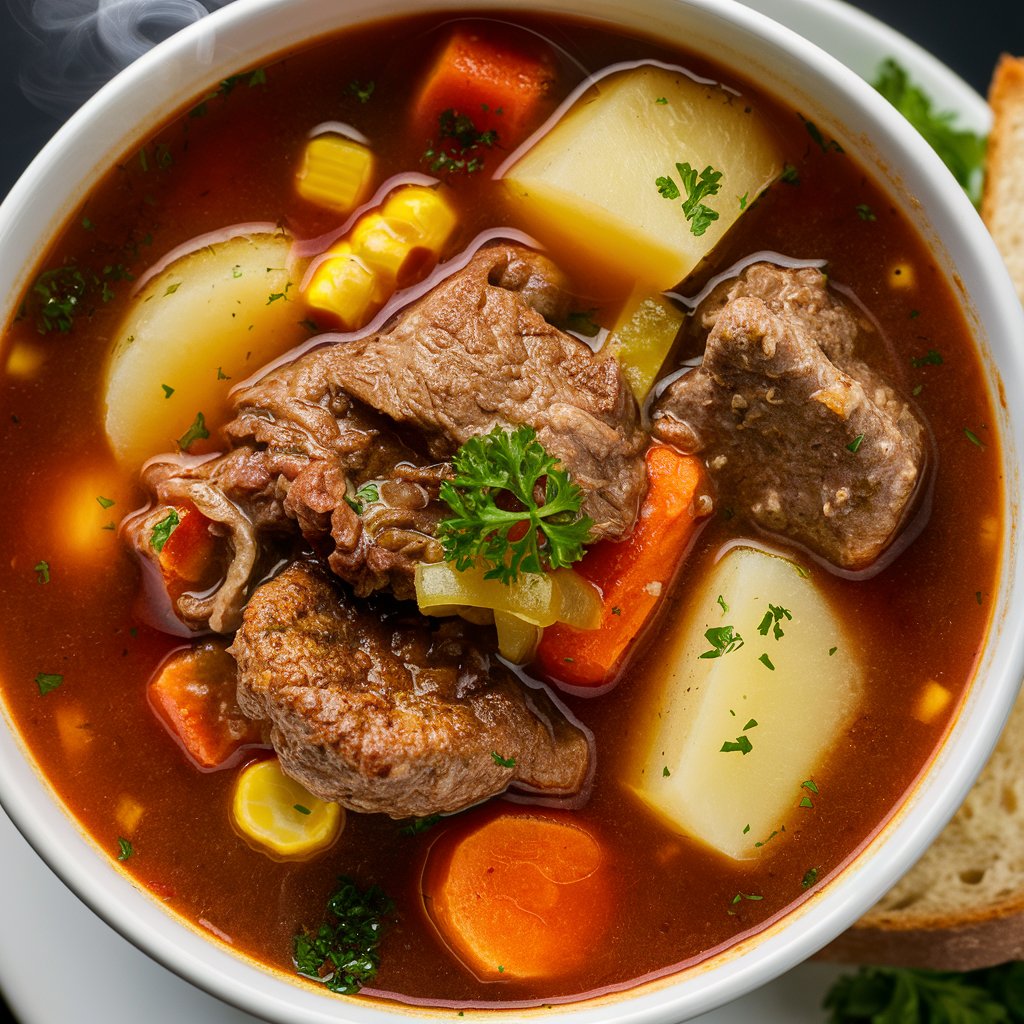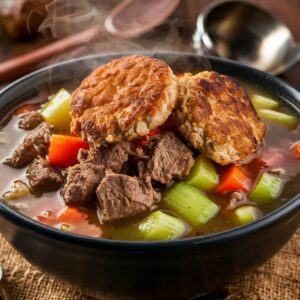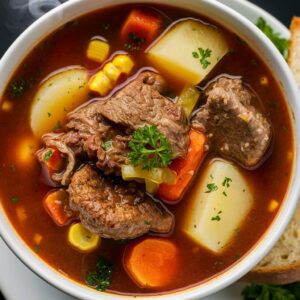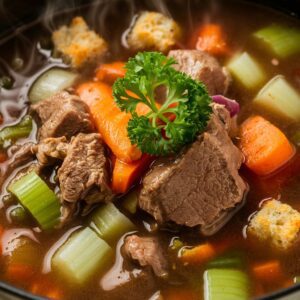Beef Hamburger Soup Recipe: A Complete Guide

Beef Hamburger Soup Recipe: A Complete Guide
Introduction
Looking for a hearty and delicious meal that’s perfect for any night of the week? Beef hamburger soup is a fantastic choice! This comforting dish combines ground beef, fresh vegetables, and a savory broth to create a meal that everyone will love. It’s not just tasty but also packed with nutrients, making it a great option for families. Let’s dive into how to make this wonderful soup.

Ingredients Needed
To start, gather all your ingredients. Here’s what you’ll need:
- 1 pound ground beef
- 1 onion, chopped
- 2 cloves garlic, minced
- 4 cups beef broth
- 2 cups water
- 3 carrots, sliced
- 2 potatoes, diced
- 1 can diced tomatoes
- 1 cup frozen peas
- 1 cup frozen corn
- Salt and pepper to taste
- 1 teaspoon dried thyme
- 1 bay leaf

Preparation Steps
- Prepare the Vegetables: Wash and chop the carrots, potatoes, and onion. Mince the garlic cloves.
- Cook the Beef: In a large pot, brown the ground beef over medium heat. Drain the fat.
- Sauté the Vegetables: Add the chopped onion and minced garlic to the pot with the beef. Sauté until the onion is translucent.
Cooking Instructions
- Add Broth and Water: Pour in the beef broth and water. Stir to combine.
- Add Vegetables: Add the carrots, potatoes, and can of diced tomatoes (with juice).
- Season the Soup: Add salt, pepper, dried thyme, and the bay leaf. Stir well.
- Simmer: Bring the soup to a boil, then reduce the heat and let it simmer for about 30 minutes, or until the vegetables are tender.
- Add Frozen Vegetables: Stir in the frozen peas and corn. Cook for an additional 5-10 minutes.
Seasoning and Flavor Enhancements
To enhance the flavor of your soup, consider adding:
- A dash of Worcestershire sauce
- A teaspoon of smoked paprika
- Fresh parsley or cilantro for garnish
Serving Suggestions
Serve your beef hamburger soup hot with a side of crusty bread or a fresh salad. It’s perfect for dipping and adds a nice texture contrast to the meal.
Storage and Reheating Tips
Leftovers? No problem! Store your soup in an airtight container in the refrigerator for up to 3 days. To reheat, simply warm it up on the stove over medium heat until hot.
Health Benefits of Beef Hamburger Soup
This soup is not only delicious but also nutritious. It’s rich in protein from the beef and loaded with vitamins and minerals from the vegetables. The beef broth adds essential nutrients like collagen and amino acids.
Variations and Substitutions
Feel free to get creative with this recipe. Here are some ideas:
- Vegetarian Version: Replace the beef with a plant-based ground meat substitute and use vegetable broth.
- Low-Carb Option: Skip the potatoes and add more low-carb veggies like zucchini or cauliflower.
- Spicy Twist: Add a chopped jalapeño or a pinch of red pepper flakes for some heat.
Common Mistakes to Avoid
- Overcooking the Vegetables: Keep an eye on your soup to ensure the veggies are tender but not mushy.
- Under-seasoning: Taste your soup before serving and adjust the seasoning as needed.
Frequently Asked Questions (FAQs)
- Can I freeze beef hamburger soup? Yes, you can freeze it in a freezer-safe container for up to 3 months.
- Can I use ground turkey instead of beef? Absolutely! Ground turkey is a great substitute and a bit leaner.
- What other vegetables can I add? Feel free to add green beans, bell peppers, or mushrooms.
- Is this soup gluten-free? Yes, just ensure your beef broth is gluten-free.
- Can I make this soup in a slow cooker? Yes, brown the beef first, then add all ingredients to the slow cooker and cook on low for 6-8 hours.

Advantages of Making Beef Hamburger Soup
- Quick and Easy: Perfect for busy weeknights.
- Nutritious: Packed with protein and veggies.
- Versatile: Easily adaptable to suit different tastes and dietary needs.
Disadvantages to Consider
- Time-Consuming Preparation: Chopping vegetables and browning meat can take time.
- Potential for Overcooking: Requires attention to ensure vegetables are cooked perfectly.
Understanding Beef Grades
What are Beef Grades?
Beef grades are a way of categorizing beef based on quality. The grading system considers factors such as marbling, color, and texture to determine the quality of the meat. Understanding these grades helps you choose the best beef for your needs.
USDA Beef Grades
The USDA classifies beef into three main grades: Prime, Choice, and Select.
- Prime: This is the highest grade, known for its abundant marbling and tenderness. Prime beef is often found in high-end restaurants.
- Choice: Slightly lower in quality than Prime, Choice beef still offers good marbling and tenderness, making it a popular choice for home cooks.
- Select: This grade has less marbling and is leaner than the other grades. It is less tender but still a good option for many dishes.
Types of Beef Cuts
Primal Cuts
Primal cuts are the large sections of a cow that are divided into smaller cuts. Understanding primal cuts helps you know where your beef comes from and its potential uses.
Popular Beef Cuts
- Ribeye: Known for its rich flavor and tenderness, ideal for grilling or pan-searing.
- Sirloin: A versatile cut that’s great for grilling, broiling, or pan-frying.
- Tenderloin: The most tender cut, perfect for roasting or making filet mignon.
Factors to Consider When Choosing Beef
Marbling
Marbling refers to the white streaks of fat within the meat. More marbling means more flavor and juiciness. Look for evenly distributed marbling for the best quality.
Color and Texture
Fresh beef should be bright red with a firm texture. Avoid meat that looks brown or feels slimy.
Aging Process
The aging process enhances the flavor and tenderness of beef. There are two main types: wet aging and dry aging.
- Wet Aging: Beef is aged in vacuum-sealed bags, which helps retain moisture.
- Dry Aging: Beef is hung in a controlled environment, allowing enzymes to break down the muscle fibers, resulting in a more intense flavor.
Source and Ethical Considerations
Choosing beef from ethical sources ensures better quality and sustainability. Grass-fed beef is often considered healthier and more environmentally friendly than grain-fed beef.
Price vs. Quality
While high-quality beef can be expensive, it often offers better flavor and tenderness. Balancing cost and quality is important to get the best value for your money.
Conclusion
Beef hamburger soup is a wholesome, flavorful dish that’s easy to make and loved by many. With its rich broth, tender vegetables, and hearty beef, it’s sure to become a favorite in your household. Give this recipe a try, and enjoy a comforting bowl of soup with your loved ones!
